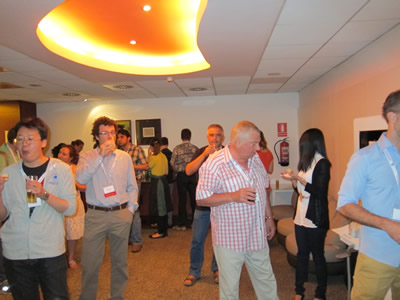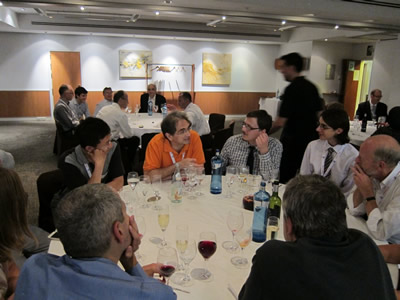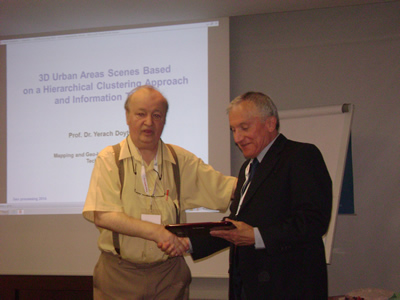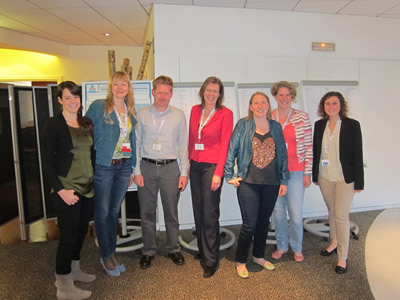PATTERNS 2022 - The Fourteenth International Conference on Pervasive Patterns and Applications
April 24, 2022 - April 28, 2022
PATTERNS 2022: Call for Papers
Onsite and Online Options: In order to accommodate a large number of situations, we are offering the option for either physical presence or virtual participation (pdf slides or pre-recorded videos).
The PATTERNS 2022 event, The Thirteenth International Conferences on Pervasive Patterns and Applications, targets the application of advanced patterns, at-large. In addition to support for patterns and pattern processing, special categories of patterns covering ubiquity, software, security, communications, discovery and decision are considered. As a special target, the domain-oriented patterns cover a variety of areas, from investing, dietary, forecast, to forensic and emotions. It is believed that patterns play an important role on cognition, automation, and service computation and orchestration areas. Antipatterns come as a normal output as needed lessons learned.
PATTERNS 2022 is aimed at technical papers presenting research and practical results, industrial small- and large-scale systems, challenging applications, position papers addressing the pros and cons of specific topics, such as those being discussed in the standard fora or in industry consortia, survey papers addressing the key problems and solutions on any of the topics, short papers on work in progress, and panel proposals.
We solicit both academic, research, and industrial contributions. We welcome technical papers presenting research and practical results, position papers addressing the pros and cons of specific proposals, such as those being discussed in the standard fora or in industry consortia, survey papers addressing the key problems and solutions on any of the above topics short papers on work in progress, and panel proposals.
Industrial presentations are not subject to the format and content constraints of regular submissions. We expect short and long presentations that express industrial position and status.
Tutorials on specific related topics and panels on challenging areas are encouraged.
The topics suggested by the conference can be discussed in term of concepts, state of the art, research, standards, implementations, running experiments, applications, and industrial case studies. Authors are invited to submit complete unpublished papers, which are not under review in any other conference or journal in the following, but not limited to, topic areas.
All topics and submission formats are open to both research and industry contributions.
PATTERNS 2022 conference tracks:
Basics on patterns
Design patterns; Static and dynamic patterns; Pattern identification and extraction; Validate patterns; Patterns’ accuracy; Incomplete patterns; Patterns and noise
Patterns at work
Pattern logics and algebras; Pattern recognition; Pattern matching; Pattern languages; Patterns languages/models pitfalls; Pattern specification/modeling; Pattern validation; Pattern composition; Pattern reuse; Testing in pattern-based designed systems; Manageability and maintenance of pattern-based designed systems; Architecture, architectural design and the built environment
Classification patterns
Dynamic ensemble selection; Diversity-based ensemble; Ensemble Classification; Ensemble Clustering; Active Learning from video streams patterns; Geodesic-based similarities; Leaf species classification; Clothing image characterization; Mountain drainage patterns; Texture classification; Large scale image categorization; Clustering Web search frequency; Descriptors for food recognition; Signal patterns; High-speed video patterns
Medical and facial image patterns
Global similarities; Image quality assessment; Discovering images ROI (Regions of Interest); Features semantic relations; Lesion detection; 3D Face structures; Facial expression recognition; Shared feature learning; Video-to-Video face recognition; Learning patterns of disabled/elderly; Using therapeutic data; Malignancy-oriented patterns; Detection of misalignment; Image-based navigation systems
Tracking human patterns
Tracking Multiple Persons; Tracking in Crowded situations; Tracking by adapting detectors; Part-based appearance; Structure-constrained motion; Structure sparsity-based representation; Dominant colors patterns; Population drift-based features; Drivers face detection; Authentication via pore patterns; Iris segmentation systems; Rapid facial movements systems; Appearance-based feature analysis; Sketch recognition patterns; Mobile devices adaptive classification; Direction change patterns; Human action recognition; Appearance-based gaze tracking patterns; Free head movement patterns; Pattern-based locaization
Action recognition patterns
Pre-classification of handwritten characters; Action classification; Classification of human actions; Activity recognition in Smart homes; Learning for activity representation; Bag-of-Words for action recognition; Room occupancy patterns
Color and texture patterns
Texture classification; Extracting texture features; Texture-based descriptors; Color image patterns; Shape co-occurrence patterns; Fluorescence microscopy images; Texture defect detection patterns
Ubiquity patterns
User mobility patterns; Social networking patterns; Content dependency patterns; Content accessing patterns; Behavioral autonomy patterns; Prediction patterns /behavioral, structure, environment/; Patterns of discovery
Software patterns
Software design patterns; Software reuse patterns; Software quality patterns; Software testing patterns; Software performance, security, and safety patterns; Software management patterns; Patterns for evolving software elements
Security patterns
Security patterns; Patterns of trust; Attack patterns; Authorization patterns; Failed access patterns; Intrusion attempt patterns; Local malware patterns; Distributed malware patterns; Predictive patterns; Mobility patterns; Tracking patterns
System management patterns
Management and control patterns; Monitoring patterns; Correlation patterns; Event patterns; Visualization patterns
Discovery and decision patterns
Search patterns; Data mining for patterns; Query patterns; Knowledge patterns; Behavioral patterns; Reasoning patterns; Decision patterns; Patterns in WWW; Predictive patterns; Mobility patterns; Tracking patterns
Communications patterns
Communication patterns; Propagation patterns; Traffic/routing patterns; P2P and P4P patterns; Configuration change patterns; System abnormal behavior patterns
Domain-oriented patterns
Forensic patterns; Genomic patterns; Image patterns; Voice patterns; Speech patterns; Hand writing patterns; Text-embedded sentiment patterns; Emotion recognition patterns; Site access patterns; Service orchestration; Keyboard typing patterns; Financial/stock patterns; Shopping patterns; Dietary patterns; Global warming patterns; Job market patterns; Stock movement patterns; Investing patterns
Antipatterns and lessons learned
Architectural; Design; Development; People and project management; Social
Deadlines:
Submission | Jan 24, 2022 |
Notification | Feb 20, 2022 |
Registration | Mar 03, 2022 |
Camera ready | Mar 10, 2022 |
Deadlines differ for special tracks. Please consult the conference home page for special tracks Call for Papers (if any).
INSTRUCTION FOR THE AUTHORS
Authors of selected papers will be invited to submit extended versions to one of the IARIA Journals.
Publisher: XPS (Xpert Publishing Services)
Archived: ThinkMindTM Digital Library (free access)
Prints available at Curran Associates, Inc.
How to submit to appropriate indexes.
Only .pdf or .doc files will be accepted for paper submission. All received submissions will be acknowledged via an automated system.
Contribution types
- regular papers [in the proceedings, digital library]
- short papers (work in progress) [in the proceedings, digital library]
- ideas: two pages [in the proceedings, digital library]
- extended abstracts: two pages [in the proceedings, digital library]
- posters: two pages [in the proceedings, digital library]
- posters: slide only [slide-deck posted on www.iaria.org]
- presentations: slide only [slide-deck posted on www.iaria.org]
- demos: two pages [posted on www.iaria.org]
FORMATS
Only .pdf or .doc files will be accepted for paper submission. All received submissions will be acknowledged via an automated system.
Final author manuscripts will be 8.5" x 11", not exceeding 6 pages; max 4 extra pages allowed at additional cost.
Helpful information for paper formatting for MS Word can be found here.
There is a community provided LaTeX template: the CTAN package iaria (with full IARIA formatting rules, including IARIA citation style, but for providing citation style it is tightly bound to pdflatex+biblatex+biber). In addition, there is also iaria-lite (not bound to pdflatex+biblatex+biber, but compatible with any TeX stack; thus, it cannot provide the IARIA citation formattings, but only the titlepage and content-related IARIA formatting rules). Based on the iaria package, there is a minimal working example as Overleaf template. When you are using the LaTeX templates, please still adhere to the additional editorial rules.
Slides-based contributions can use the corporate/university format and style.
Your paper should also comply with the additional editorial rules.
Once you receive the notification of contribution acceptance, you will be provided by the publisher an online author kit with all the steps an author needs to follow to submit the final version. The author kits URL will be included in the letter of acceptance.
We would recommend that you should not use too many extra pages, even if you can afford the extra fees. No more than 2 contributions per event are recommended, as each contribution must be separately registered and paid for. At least one author of each accepted paper must register to ensure that the paper will be included in the conference proceedings and in the digital library, or posted on the www.iaria.org (for slide-based contributions).
CONTRIBUTION TYPE
Regular Papers (up to 6-10 page article -6 pages covered the by regular registration; max 4 extra pages allowed at additional cost- ) (oral presentation)
These contributions could be academic or industrial research, survey, white, implementation-oriented, architecture-oriented, white papers, etc. They will be included in the proceedings, posted in the free-access ThinkMind digital library and sent for indexing. Please submit the contributions following the instructions for the regular submissions using the "Submit a Paper" button and selecting the appropriate contribution type. 12-14 presentation slides are suggested.
Short papers (work in progress) (up to 4 pages long) (oral presentation)
Work-in-progress contributions are welcome. These contributions represent partial achievements of longer-term projects. They could be academic or industrial research, survey, white, implementation-oriented, architecture-oriented, white papers, etc. Please submit the contributions following the instructions for the regular submissions using the "Submit a Paper" button and selecting the contribution type as work in progress. Contributors must follow the conference deadlines, describing early research and novel skeleton ideas in the areas of the conference topics. The work will be published in the conference proceedings, posted in the free-access ThinkMind digital library and sent for indexing. For more details, see the Work in Progress explanation page. 12-14 presentation slides are suggested.
Ideas contributions (2 pages long) (oral presentation)
This category is dedicated to new ideas in their very early stage. Idea contributions are expression of yet to be developed approaches, with pros/cons, not yet consolidated. Ideas contributions are intended for a debate and audience feedback. Please submit the contributions following the instructions for the regular submissions using the "Submit a Paper" button and selecting the contribution type as Idea. Contributors must follow the conference deadlines, describing early research and novel skeleton ideas in the areas of the conference topics. The work will be published in the conference proceedings, posted in the free-access ThinkMind digital library and sent for indexing. For more details, see the Ideas explanation page. 12-14 presentation slides are suggested.
Extended abstracts (2 pages long) (oral presentation)
Extended abstracts summarize a long potential publication with noticeable results. It is intended for sharing yet to be written, or further on intended for a journal publication. Please submit the contributions following the instructions for the regular submissions using the "Submit a Paper" button and selecting the contribution type as Extended abstract. Contributors must follow the conference deadlines, describing early research and novel skeleton ideas in the areas of the conference topics. The work will be published in the conference proceedings, posted in the free-access ThinkMind digital library and sent for indexing. 12-14 presentation slides are suggested.
Posters (paper-based, two pages long) (oral presentation)
Posters are intended for ongoing research projects, concrete realizations, or industrial applications/projects presentations. The poster may be presented during sessions reserved for posters, or mixed with presentation of articles of similar topic. A two-page paper summarizes a presentation intended to be a POSTER. This allows an author to summarize a series of results and expose them via a big number of figures, graphics and tables. Please submit the contributions following the instructions for the regular submissions using the "Submit a Paper" button and selecting the contribution type as Poster Two Pages. Contributors must follow the conference deadlines, describing early research and novel skeleton ideas in the areas of the conference topics. The work will be published in the conference proceedings, posted in the free-access ThinkMind digital library and sent for indexing. 8-10 presentation slides are suggested. Also a big Poster is suitable, used for live discussions with the attendees, in addition to the oral presentation.
Posters (slide-based, only) (oral presentation)
Posters are intended for ongoing research projects, concrete realizations, or industrial applications/projects presentations. The poster may be presented during sessions reserved for posters, or mixed with presentation of articles of similar topic. The slides must have comprehensive comments. This type of contribution only requires a 8-10 slide-deck. Please submit the contributions following the instructions for the regular submissions using the "Submit a Paper" button and selecting the contribution type as Poster (slide-only). The slide-deck will be posted, post-event, on www.iaria.org.
8-10 presentation slides are suggested. Also a big Poster is suitable, used for live discussions with the attendees, additionally to the oral presentation.
Presentations (slide-based, only) (oral presentation)
These contributions represent technical marketing/industrial/business/positioning presentations. This type of contribution only requires a 12-14 slide-deck. Please submit the contributions following the submission instructions by using the "Submit a Paper" button and selecting the contribution type as Presentation (slide-only). The slide-deck will be posted, post-event, on www.iaria.org.
12-14 presentation slides are suggested.
Demos (two pages) [posted on www.iaria.org]
Demos represent special contributions where a tool, an implementation of an application, or a freshly implemented system is presented in its alfa/beta version. It might also be intended for thsoe new application to gather the attendee opinion. A two-page summary for a demo is intended to be. It would be scheduled in special time spots, to ensure a maximum attendance from the participants. Please submit the contributions following the submission instructions by using the "Submit a Paper" button and selecting the contribution type as Demos. The Demos paper will be posted, post-event, on www.iaria.org.
Tutorial proposals
Tutorials provide overviews of current high interest topics. Proposals should be for 2-3 hour long. Proposals must contain the title, the summary of the content, and the biography of the presenter(s). The tutorial slide decks will be posted on the IARIA site.
Please send your proposals to tutorial proposal
Panel proposals
The organizers encourage scientists and industry leaders to organize dedicated panels dealing with controversial and challenging topics and paradigms. Panel moderators are asked to identify their guests and manage that their appropriate talk supports timely reach our deadlines. Moderators must specifically submit an official proposal, indicating their background, panelist names, their affiliation, the topic of the panel, as well as short biographies. The panel slide deck will be posted on the IARIA site.
Please send your proposals to panel proposal












































